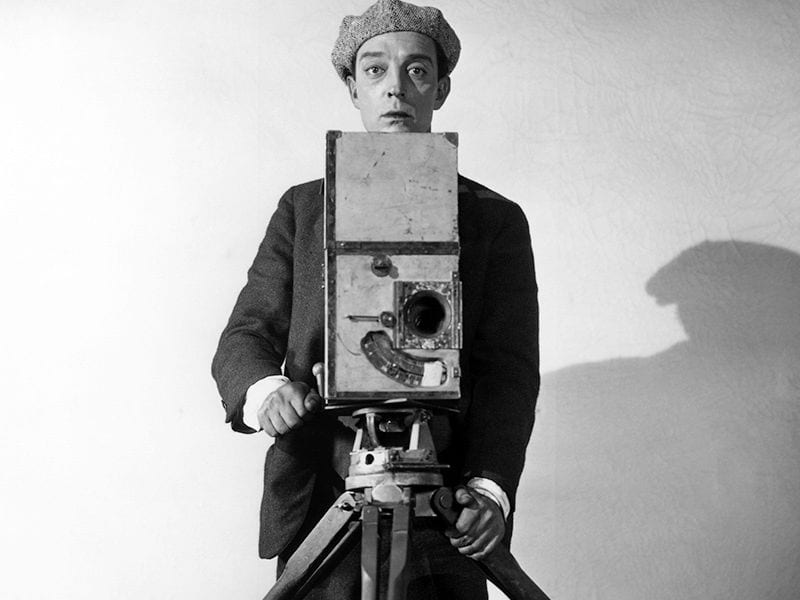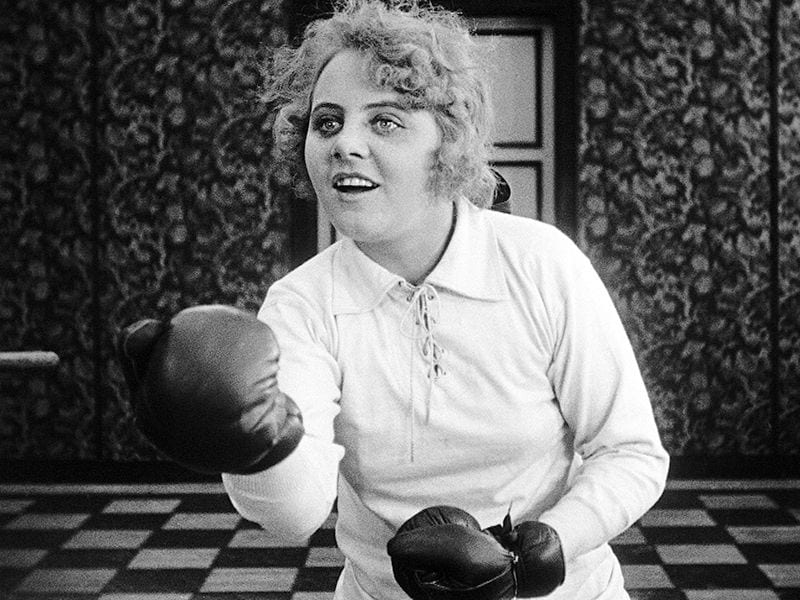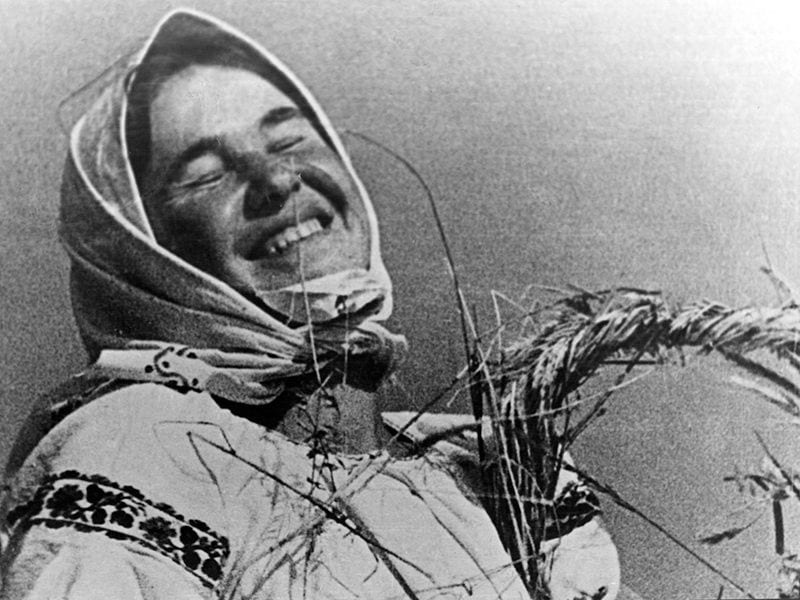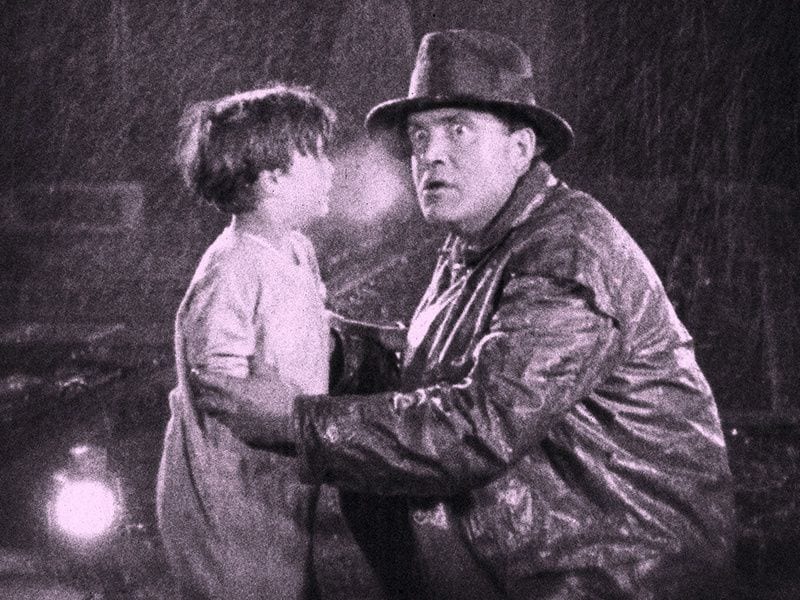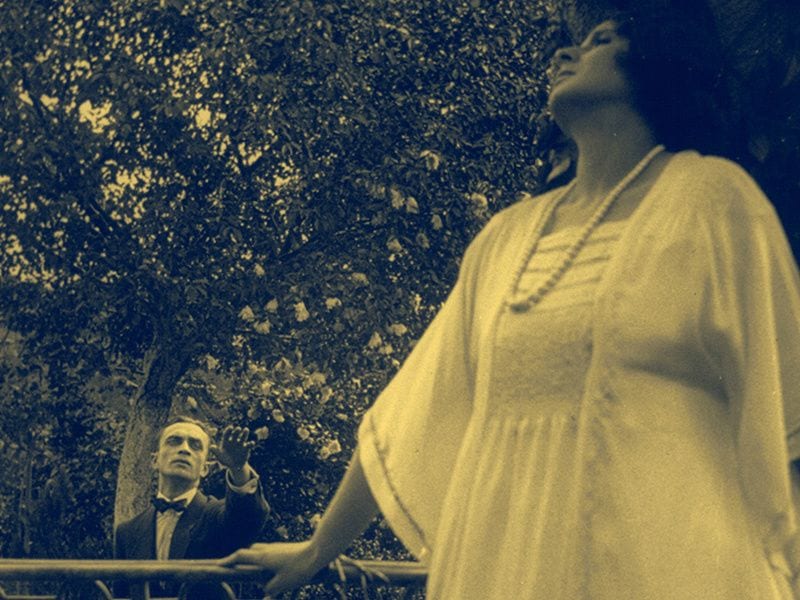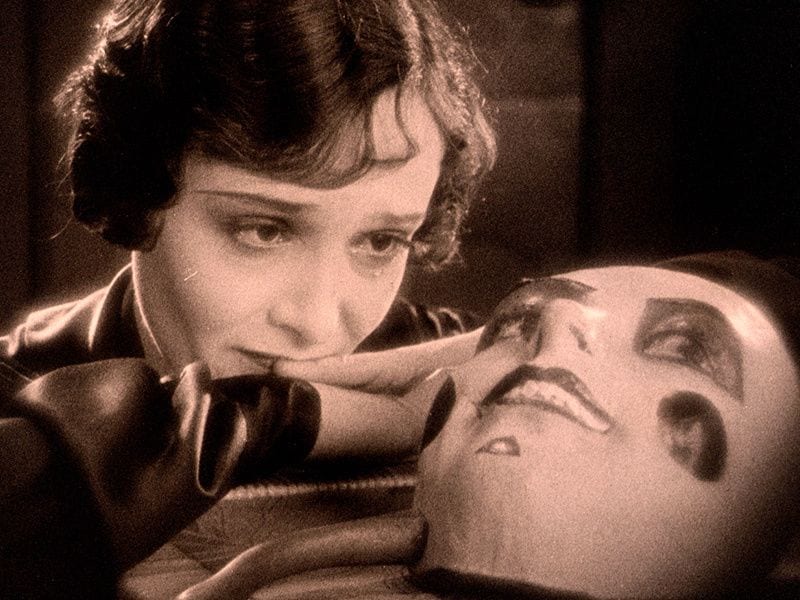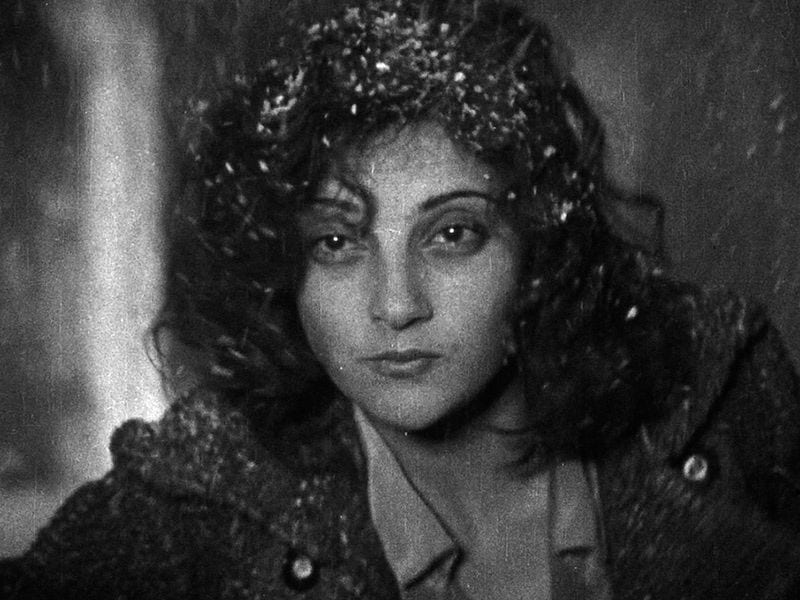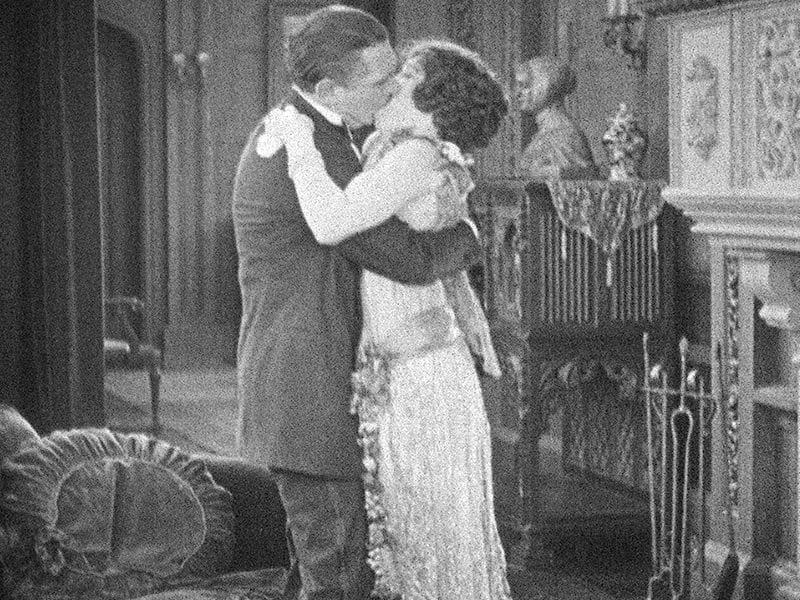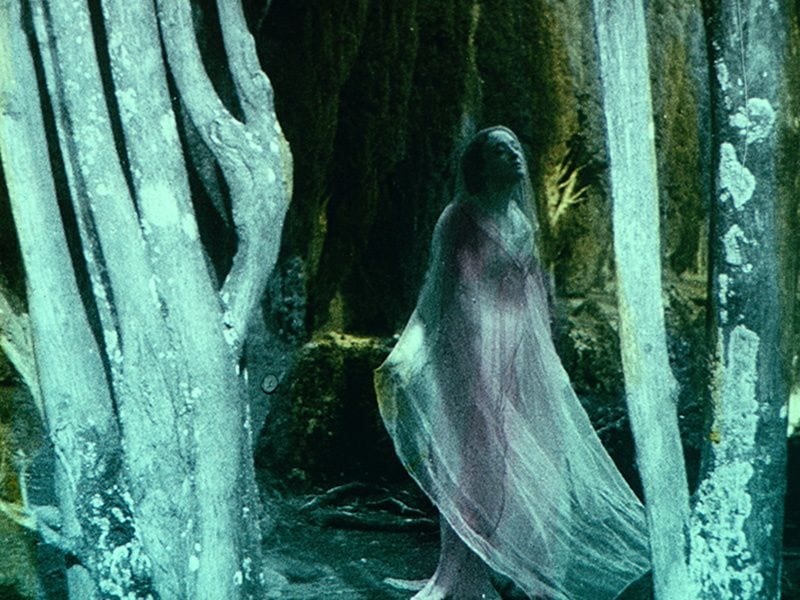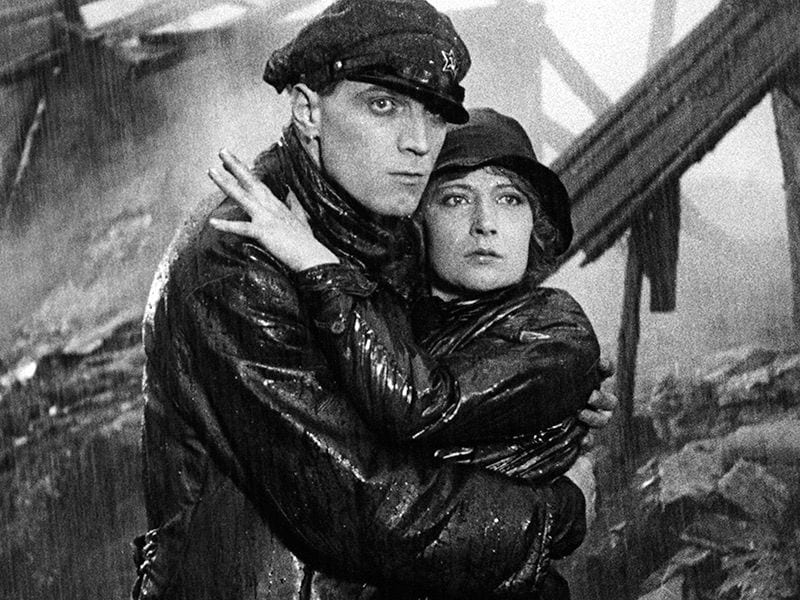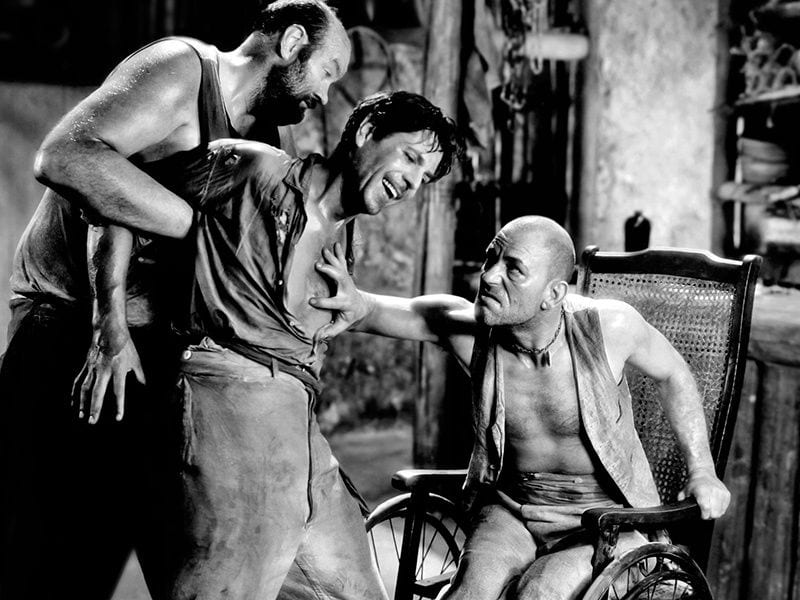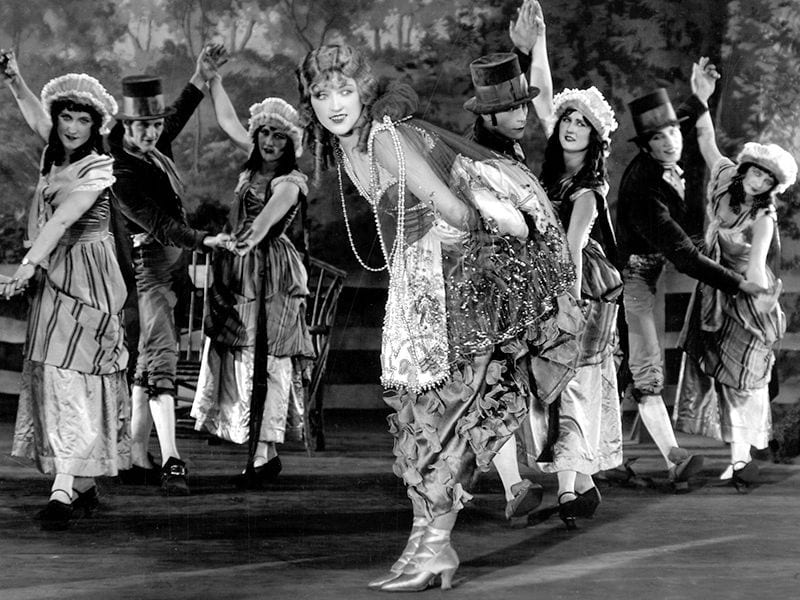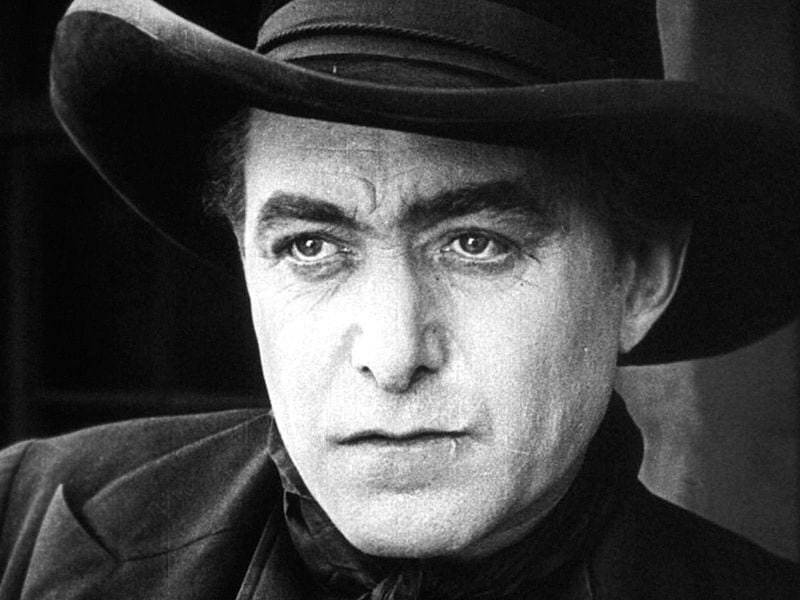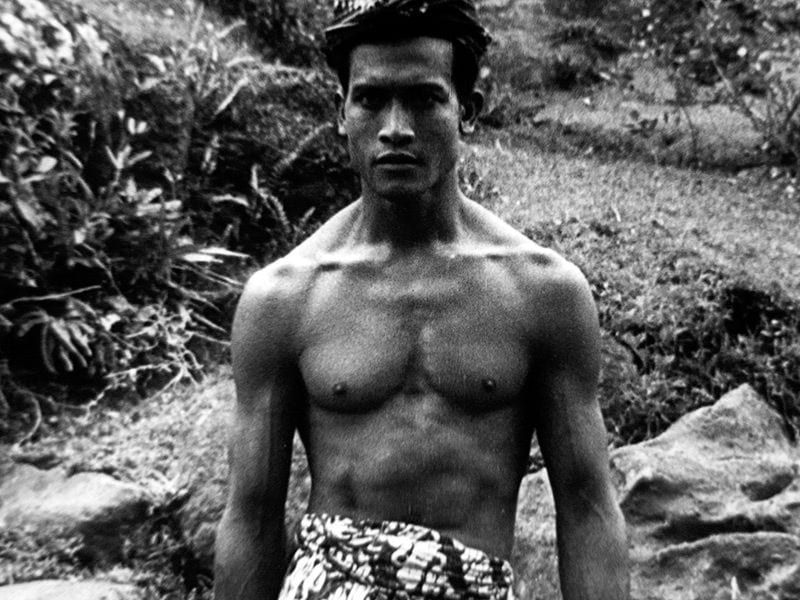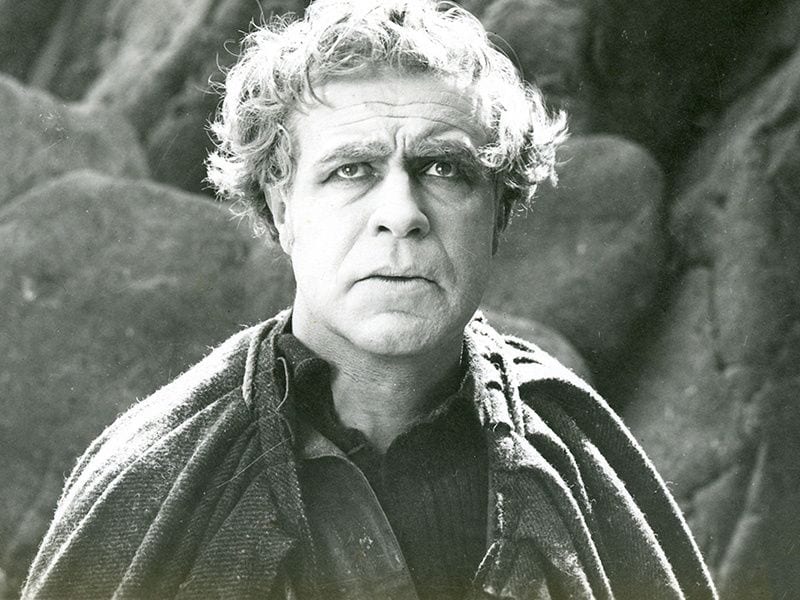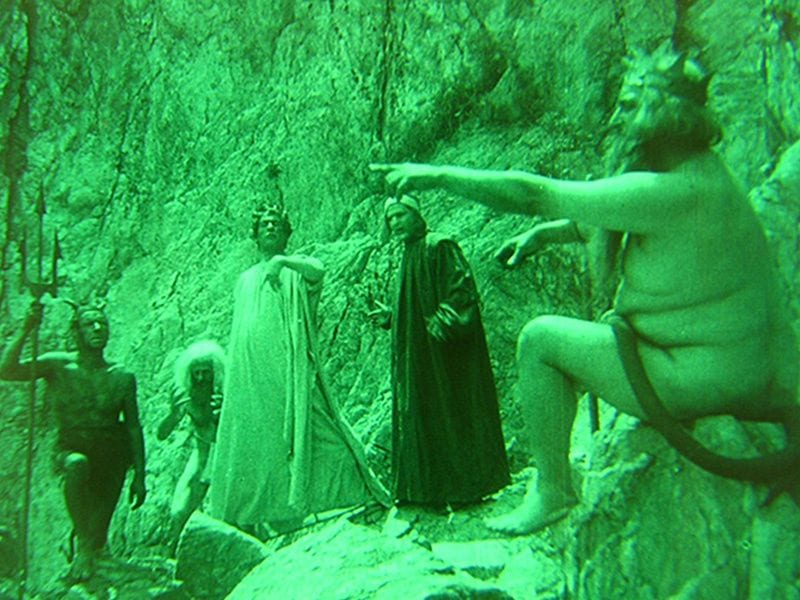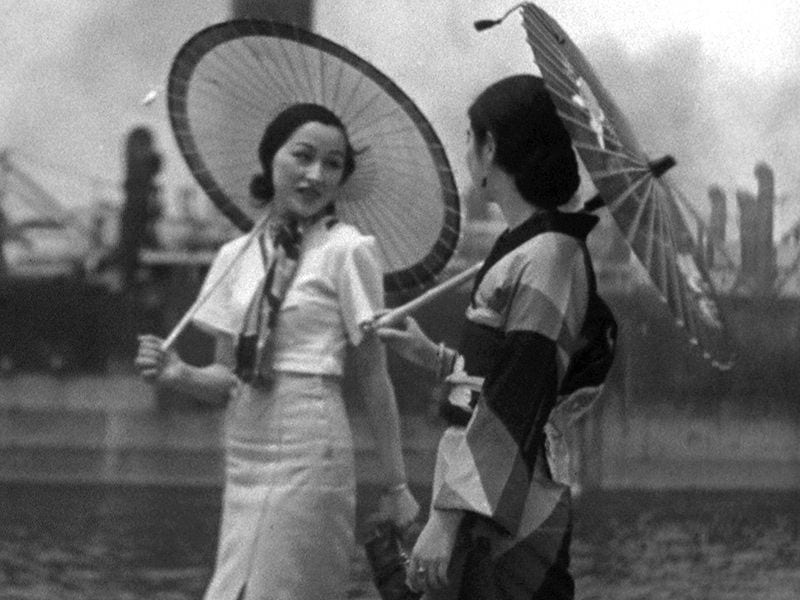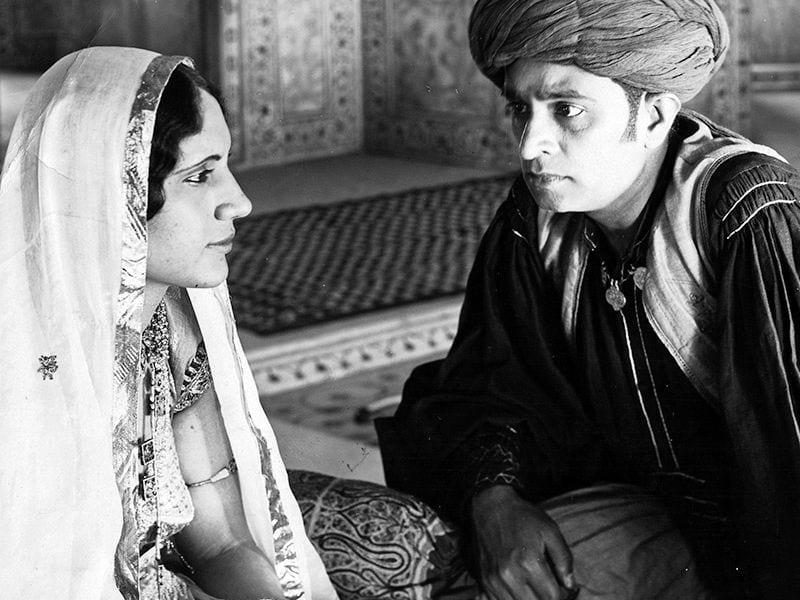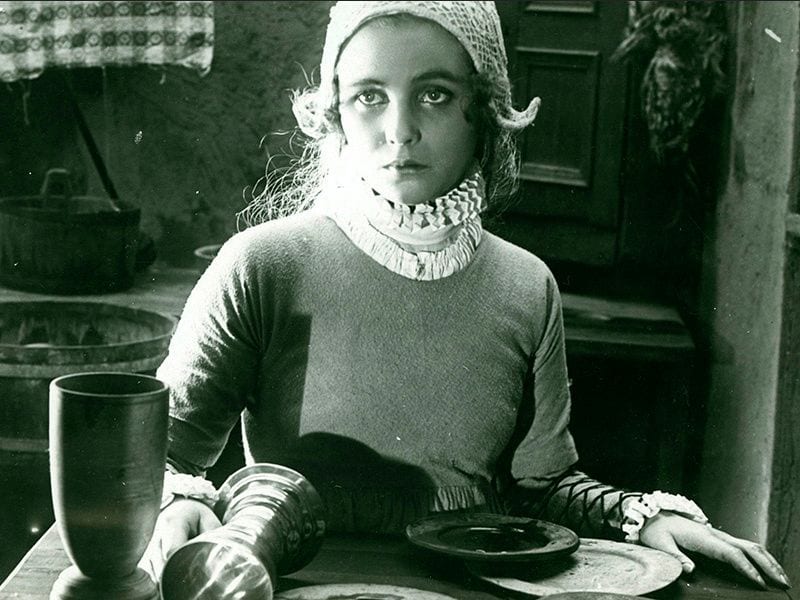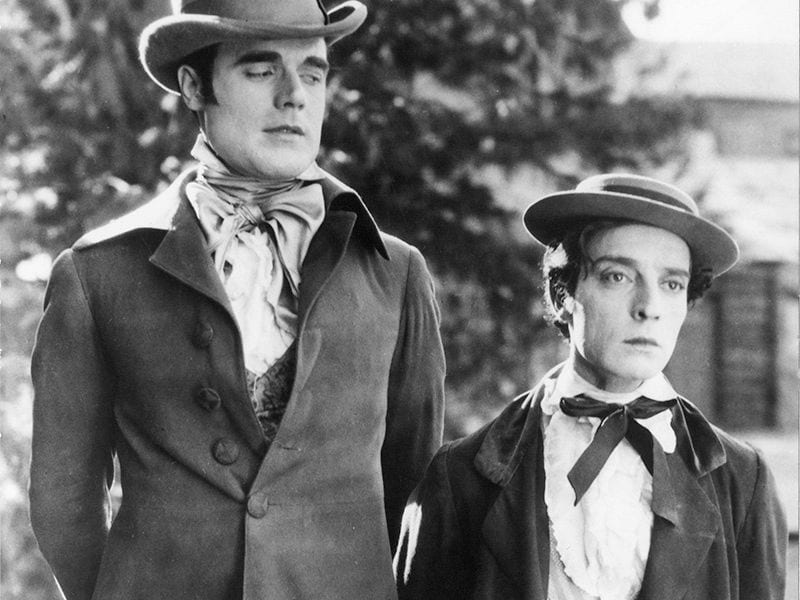I tend to assume that the truth is the opposite of what everyone thinks. As it’s “common knowledge” that today’s audiences “don’t like old movies” and can’t sit through “black and white movies”, so it goes without saying that nobody can stomach silent movies.
Meanwhile, back in reality, increasing numbers of silent restorations emerge in digital form and support increasing numbers of festivals. The age of home video has encouraged the knowledge and fascination with this art form across several generations, so that more people watch silent films today than at any time since the talkies supposedly killed them. For example, the San Francisco Silent Film Festival is celebrating its 24th installment during the first five days in May, and that’s a pretty good run for something nobody cares about, supposedly.
And why not? Silent movies were never silent, as the live musical accompaniment proves. They often weren’t black and white, as shown by the prevalence of tinting and the emergence of various color processes. They weren’t herky-jerky and faded to a blur, as shown by proper restorations shown at the right projection speed. They weren’t overblown and exaggerated, as shown by the delicacy and subtlety of detail and expression that mark the general run of silent classics. What they were was absorbing, artful, emotional and spellbinding, as shown by this year’s selection of programs.
The following remarks are based on our viewing of screeners, which don’t always reflect the condition of what will be projected and make no mention at all of how the live music will go. We also can have nothing to say about two special programs of shorts, the “Grand Tour Italiano” (Wednesday, May 1st) and “Amazing Tales from the Archives” (Thursday, May 2nd). As for the rest, Dear Reader, this is what we know.
The festival kicks off with an illustrated lecture on Italian travelogues of 1905 to 1914, presented at Berkeley’s Pacific Film Archive at 3PM on Wednesday. There’s also an opening night party at McRoskey Mattress Company Building, 1687 Market Street, at 8PM. Aside from that, all screenings take place at San Francisco’s Castro Theatre and all feature live musical accompaniment by a variety of artists. Check the website for tickets and more info.
The Cameraman (1928) / Wednesday, May 1st, 7PM
Director: Buster Keaton, Edward Sedgwick
There’s a rumor that after Buster Keaton went to MGM, his films became less his own creations and therefore lesser efforts. Based on the sheer amount of laughs in this film and Spite Marriage (1929), you’d never know it. Buster takes a job as a newsreel cameraman and busts his hump all over New York, carrying the camera around like a cello and attempting to shoot something “real”. As they say commonly but rarely so accurately, hilarity ensues.
While some politically correct viewers may wish to take issue with the convention of a “Tong war” in Chinatown, they should understand that this film parodies a well-worn cliché, and the whole concept is further undermined by the tension between cartoonish riot and the small dogged stillness that is Keaton at the center of the frame. There’s a message here about cinema, about how the camera’s presence turns reality into exploitable fantasy for profit and entertainment, but most viewers will probably be too busy laughing to analyze it.
Wolf Song (1929) / Thursday, May 2nd, 1:15PM
Director: Victor Fleming
Set in 1840, this western romance demonstrates how silent films specialize in the dramatically simple and emotionally complex. On one level, it’s about two beautiful sex objects, as played by curly-headed Gary Cooper and beauty-curled Lupe Velez, whose characters will ensnare each other. Cooper plays a trapper who ran away from a shotgun wedding in Kentucky and has had plenty of experience in a movie surprisingly frank about sex. “Lots o’ gals has had aholt o’ me,” he says while bathing nude in the movie’s show-stopping display of flesh. “Ain’t you the pretty white thing,” jeers one of his compadres.
Velez plays the secluded Mexican daughter of a Taos bigwig. She’s clearly a virgin, but the thought of sex visibly excites her when she discusses it with a friend. Her father will gladly kill the gringo who looks at her, but when Lola Salazar decides to run away with Sam Lash, her animal fright and beauty convinces him to delay the physical side until they’re properly wed. The story becomes a battle of wills that redefines masculinity as he learns that, despite his urge to roam, love is stronger than anything.
Director Victor Fleming touches on similar themes in the same year’s The Virginian (1929) and had a run on male bonding of the type seen here, where friendship is expressed physically by fighting in a bar or on the trail. This film has three big scenes of male wrestling in different modes, one broken up by Velez at her most fiery; one of these scenes features wrestler Constantine Romanoff, who had a big fight with Harold Lloyd in The Kid Brother (1927). This late silent was released with a synchronized score but will play at the Festival with live accompaniment.
The Oyster Princess (Die Austernprinzessin) (1919) / Thursday, May 2nd, 3PM
Director: Ernst Lubitsch
Ernst Lubitsch became famous for subtle and sophisticated comedies, but first he made his name with knockabout slapstick of a type not very subtle at all. He and co-writer Hanns Kräly construct a broad satire of American millionaires in which the Oyster King, Mr. Quaker (Victor Janson), is an enormous walrus-like figure attended by liveried servants who do everything for him. His spoiled daughter (Ossi Oswalda) starts smashing furniture because she wants to marry royalty, so daddy buys an impoverished European prince (Harry Liedtke) through a matchmaker. (Compare this plot point with Saturday’s showing of The Wedding March.) First comes a mix-up with the prince’s bald proxy (Julius Falkenstein), who gets soused and declares “I could get married like this every day.”
The story is one absurd and witty sight gag after another, reaching a climax during the elaborately choreographed wedding feast and the outbreak of a “foxtrot epidemic”. There’s also an all-women boxing match. The whole thing is a giddy, drunken spree, though the saucy keyhole honeymoon gags announce the cosmopolitan sophistication and sly sexual knowledge that would mark Lubitsch’s later comedies. This 2012 restoration print looks clean as a whistle.
Earth (Zemlya) (1930) / Thursday, May 2nd, 5PM
Director: Alexander Dovzhenko
This film isn’t available for preview. Your indefatigable reviewer recalls seeing and liking it many years ago, for basically all the classics of Soviet silent cinema are gripping and rigorous examples of expressive editing, vivid composition, and fluid storytelling. In this case, Dovzhenko made a paean to Ukrainian farming that supposedly propagandizes the new policy of collectivization against the recalcitrant Kulaks (local land-owning farmers), yet the film was attacked within the Soviet Union for being naïve and insufficiently ideological. What mattered to him, and to us now, is the lyrical beauty of the imagery and the rhythms of the cutting, even when promoting the idea that farmers can fix a tractor’s overheated radiator by urinating on it.
The Signal Tower (1924) / Thursday, May 2nd, 7PM
Director: Clarence Brown
The Universal Jewels were the studio’s big-budget prestige pictures, and here’s a lovely and spectacular example. Trains were a popular subject of the silent era, and this story takes place at a small station in an almost fairy-tale forest where the hero (Rockliffe Fellowes) works as a signalman and lives nearby with his idealized wife (Virginia Valli) and son (Frankie Darro). She tells her husband he’s like all men in that he doesn’t see the danger that women feel. In this case, the new relief man (Wallace Beery) is a “railroad sheik” with a record marked by vanity and sexual predation. He’ll spell trouble during a thunderous climax with a runaway train.
Director Clarence Brown is among the most unashamedly sentimental of pictorialists, allowing his characters to cry freely and express the full range of emotions. With expert cross-cutting, the ending ratchets up the excitement to a pitch that must have a packed audience squirming amid the multiple crisis points. Since the only sources for this film are two 16mm prints from the home-movie market, it’s amazing this tinted restoration looks as great as it does.
Opium (1919) / Thursday, May 2nd, 9PM
Director: Robert Reinert
“It is as if our terrible era has lost all sense of happiness. A fearsome lack of joy is oppressing mankind. Which is why some of our finest and best are driving their weary souls into a state of intoxicated happiness through opium!” So speaks Prof. Gesellius (Eduard von Winterstein), and he oughta know. He got hooked by a Fu Manchu-esque Nung-Tschang (Werner Krauss, future Caligari) who hates Europeans since one seduced his wife and gave her the mixed-race daughter Sin (Sybill Morell). Meanwhile, the Prof’s wife (Hanna Ralph) carries on with a young man (Conrad Veidt, out-camping all) who’s Sin’s half-sister, while their father shows up incognito. There will be a quiz. Also an Indian jungle full of lions (!?) and opium dreams with fauns and topless nymphs.
While most silent features are more subtle and delicate than non-initiates imagine, Opium isn’t one of those. It’s over-the-top camp, with actors gesturing to the rafters, clutching each other, and rolling their eyes at the camera. The fact that European actors play Indian and Chinese people should be of no greater concern than the fact that Indian and Chinese films habitually cast their own nationals as Europeans. What’s more pertinent is that everyone is a pulp stereotype.
The sheer absurdity of tone, seemingly parodic without trying, is what makes it so watchable for those who haven’t lost all sense of happiness in our terrible era’s fearsome lack of joy. Fortunately, silent films are as addictive yet more edifying than the average opiate, and this one’s clearly the product of a neurotic culture — which still feels strangely familiar. Only a couple of years after the end of WWI, this film’s plot critiques the hero-worship and megalomania that will increasingly factor into German adventure films while mixing colonialist exotica with xenophobia. This great-looking tinted print is the result of a very complicated 2018 restoration from inferior elements that contradict each other.
You Never Know Women (1926) / Friday, May 3rd, 10AM
Director: William A. Wellman
William Welllman has made elegant use of shadows to convey serious issues before, and uses them in silent film You Never Know Women with a flourish. Enjoy Michael Barrett’s “Silent Film You Never Know Women Makes the Most of Light and Shadow” here on PopMatters.
Tonka of the Gallows (Tonka Šibernice) (1930) / Friday, May 3rd,12PM
Director: Karel Anton
The first Czech film with a synchronized soundtrack (the heroine utters a song and a prayer) is a masterpiece of humane tear-jerking. The first act presents a rural paradise so lyrical, we know something must be wrong as Tonka (Ina Rita) visits from her “good position” in the city to greet her mother (Vera Baranovskaya, star of Pudovkin’s 1926 Mother). We soon realize that Tonka won’t marry her rustic boyfriend (Jack Mylong) because, in fact, she’s a prostitute. She agrees to spend the night with a condemned man in a sequence of dazzling Expressionist shadows and moving sentiment. Karel Anton’s direction is an exquisite blend of sensitive acting, calibrated pacing, beautiful compositions, graceful camera moves and vivid subjective effects. The French print looks excellent. Don’t miss this.
Indeed, this is among the best films in this year’s festival that demonstrate one of the most common tropes or assumptions of the silent era: the rough and healthy “purity” of the rural countryside vs. the vicious and debilitating life of the city, which is simultaneously condemned and exploited as the place where everyone has fun at the cost of their lives and souls.
Husbands and Lovers (1924) / Friday, May 3rd, 2:15PM
Director: John M. Stahl
“Dedicated to the poor American wife who has a husband — and craves a lover” says the opening of this divorce comedy. The topic of divorce had been trending in sophisticated comedies about well-heeled upper classes since Cecil B. DeMille cornered the market with items like Don’t Change Your Husband (1919). Here, the elegance is handled by John M. Stahl, who would become one of the most prominent directors of “women’s” tearjerkers.
Grace (Florence Vidor) becomes fed up with being taken for granted by her husband Jim (Lewis Stone), especially when she receives flattery from their friend Rex (Lew Cody, looking eternally befuddled) after she bobs her hair in the latest style. Jim says Rex would tell a one-legged woman that her crutch was becoming. Misunderstandings and civilized behavior, in scrupulous avoidance of melodrama, escalate until the inevitable ending in which a tired couple must learn to re-appreciate each other. The most suggestive element is the title. This type of piffle had been told before and would be told again; here it’s handled with professionalism as a showcase for the attractive and intelligent Vidor, and mounted with MGM’s standard gloss. The Library of Congress print is the bee’s knees.
Rapsodia Satanica (1917) / Friday, May 3rd, 5PM
Director: Nino Oxilia
This sensual delight tells the fable of an old woman, living in her “castle of illusions”, who accepts a deal from a grinning Mefisto. She can regain her youth as long as she foregoes love. So she becomes a cold-hearted vamp, as would we all. Plans go awry when she encounters two brothers. This is one of the films of Lyda Borelli, known as the Divine Lyda, a diva of stage and screen who became one of Italy’s most imitated fashionistas in a trend called Borellismo. Director Nino Oxilia, also a noted playwright, died in WWI, and this film is a socko example of his visual flair.
What makes this 2015 restoration magical is the use of color. Aside from tints, most scenes have hand-colored stencils to highlight certain objects, especially clothing. We first notice this during the dazzling shot of the red-cloaked Mefisto (Ugo Bazzini) stepping from the painting, and the charming use of color is prominent throughout a movie that’s frequently shot outdoors in beautiful compositions. Opera composer Pietro Mascagni wrote his only film score for this, and it’s floridly romantic and effective, but we don’t know if that will be played by the Mont Alto Motion Picture Orchestra. The screening will be preceded by examples of early Kinemacolor shorts from the archives of Cineteca di Bologna.
The Love of Jeanne Ney (Die Liebe der Jeanne Ney) (1927) / Friday, May 3rd, 7:10PM
Director: G.W. Pabst
Wow. Here’s one of the best films of this year’s line-up. This melodrama begins amid the storm of Revolutionary Russia, where a French diplomat’s daughter (Edith Jehanne) is in love with a young Bolshevik (Ugo Henning), and they’re a gorgeous pair. Events sweep them to Paris, where Jeanne lives with her detective uncle (E.A. Licho) and his blind daughter (Brigitte Helm, looking more fetching and winsome than in her usual strong roles). Their comical affair of a missing diamond gets mixed up with the diabolical schemes of a baddie (Fritz Rasp in one of his oiliest roles). This film balances so many tones and elements in its hectic romantic tale that it’s impossible to know how it’s going to turn out.
From the opening shot across Rasp’s legs to his addled face, this film adopts an unusually intimate camera technique. Often hand-held, it swerves, swings and swivels in an almost giddy manner, plunging the viewer into the middle of actions and emotions. G.W. Pabst directed several great films, but none more vigorous and alive. The plot’s Russian angle seems to have inspired him to adopt their cinema’s heightened stylization and combine it with F.W. Murnau’s more vibrant moves. The resulting package is a delicious, suspenseful, satisfying entertainment, and this 2015 2K restoration looks bodacious.
West of Zanzibar (1928) / Friday, May 3rd, 9:20PM
Director: Tod Browning
“He made me this thing that crawls… Now I’m ready to bite!” snarls shaven-headed Phroso (Lon Chaney), the ex-magician who becomes confined to a wheelchair on the night a rival (Lionel Barrymore) stole his wife 18 years ago. Revenge plus the grotesque and macabre equals the cinema of Tod Browning, especially when Chaney is thrown into the mix as another of his transformed, physically challenging performances of obsessive maniacs.
The most politically incorrect movie of the festival finds Barrymore’s character as an ugly colonial-capitalist exploiting African labor — consistently called cannibals — to harvest ivory tusks. Phroso has tracked him down and, with his own illusionist voodoo, thrown a wrench into his rival’s enterprise in order to lead him to his doom. Phroso’s cruelty and sadism backfire in his face before the harrowing tale is through. The magician’s greatest trick is pulling a strange form of redemption out of his hat.
Lights of Old Broadway (1925) / Saturday, May 4th, 10AM
Director: Monta Bell
It’s the old twins-separated-at-birth ploy. One baby girl is adopted by a wealthy New York family while the other is raised as a rambunctious “shanty Irish” lass. Both grow up to be played by Marion Davies, and thus embody her dual film personas as “the funny one” and “the classy one”. These personas usually alternated, but here they’re sharing the same movie.
Full of nostalgic references and “famous people” cameos that are anachronistically at odds with each other, the plot nods at issues of political corruption (Tammany Hall), capitalist landlords, anti-Irish prejudice and inter-Irish factions (including an Orangemen riot) while not forgetting to lather on the comedy and romance. Conrad Nagel plays a dashing suitor who invests in electricity while fighting his hidebound father. And as in so many silents, a rivalry between men can be turned into friendship if only they take the chance to whale the tar out of each other. (Isn’t that how it works in life?) In the film’s most special effect, scenes on stage at Tony Pastor‘s theatre are shot in two-strip Technicolor, as is the scene of lighting New York’s arc lamps for the first time. The latter also uses the Handshiegl stencil process for the “Red Hawk” masks.
Hell Bent (1918) / Saturday, May 4th, 12PM
Director: John Ford
This western belongs to a series of collaborations between director John Ford and star Harry Carey, whose ingratiating regular-guy-ness embodied a type called “the Good Bad Man” (see also the 1916 Douglas Fairbanks western, The Half Breed, directed by Allan Dwan), a hero as bad as he is good. This 1918 effort already presents self-conscious framing devices about mythologizing the West. We’re introduced to a novelist (he must be, since he smokes a pipe) who receives a letter stating that the public is tired of pure heroes, who don’t really exist, and wants a mixture of good and bad. Then the camera dollies in on a picture by Frederic Remington, which comes to life and kicks off the action.
Harry (the character’s name as well as the actor’s) is introduced as a drunken card-sharp who escapes the law before becoming best buddies with an ornery bed mate when they find harmony in song. That’s the funniest sequence, and then Harry falls for a sweet heroine (Neva Gerber) because the public evidently still wants those characters to be pure and simple. His feelings for her motivate his confrontations with robbers, leading to a sandy desert storm. Apparently only a single print exists of this film in a Czech archive; despite Universal’s restoration, it’s riddled with jumps from missing frames and bits of action. Striking visual moments include the use of silhouettes on the sand and a shot that pans down a hill to follow a tumbling carriage before it’s overtaken by its own abandoned horses.
An extra is Fred Hibbard’s short Brownie’s Little Venus (1921), starring Baby Peggy and a talented dog. Half the film is Peggy getting dressed and undressed, with special attention to tying a corset. Either it’s a parody of women’s fashions or a sign that she’s already brainwashed. Also, piquant observations are made on burglary and gluttony; Peggy is doubled with the burglar because they’re both midnight raiders.
Goona Goona (1930) / Saturday, May 4th, 2:30PM
Director: André Roosevelt
This film hails from the golden age of ethnographic docudramas triggered by the success of Robert Flaherty’s Nanook of the North (1922) and which flourished into the early talkie era. In 1928, André Roosevelt (whose father was a cousin of Theodore Roosevelt) and his photographer and son-in-law, Armand Denis, traveled to Bali and cast local actors in a legend or historical anecdote about a tragic love triangle caused by a westernized prince who has just returned from abroad and wears a coat and tie above his sarong. His father blames his foreign education for his foolish ideas of marrying outside his class. The real problem, however, is that the woman isn’t interested in him but in a young man of her own caste.
The simple story of a romantic paradise spoiled by newfangled ideas and old-fashioned traditions, including the titular “goona goona” love magic performed by a male witch, serves as an excuse for footage of authentic dances and ceremonies. In some releases, this film got away with lots of bare-breasted footage, for US censors could be forgiving about non-white nudity in a National Geographic context. Seen today, the film remains very pretty and packed with eye candy as it provokes thoughts about the interdependence of promotion, preservation and exploitation of culture.
As a result of this movie’s great success, which triggered something of a Bali craze, the term “goona goona” became slang for salacious material and a subgenre of exploitation films that got around censorship by fabricating “exotic” lifestyles. The original soundtrack of narration and authentic Balinese music is being replaced at this screening by live music from Club Foot Orchestra.
Michelle Chin has written an informative page on this film and the history of Bali in cinema; she claims Goona Goona was first released in 1930, while IMDB lists it as a 1932 film called Kriss. Apparently it was also released as Love Powder.
L’Homme du Large (1920) / Saturday, May 4th, 4:30PM
Director: Marcel L’Herbier in L’Homme du Large
One of the festival’s best films illustrates the strength and power of silent cinema. In a story based entirely on the emotional relations of a fishing family (the title means “man of the open sea”), nothing of titanic import happens, unless you count the turns of the human heart. Marcel L’Herbier illustrates the characters and their emotions with simplicity and depth, with infinite attention to detail, with the physical reality of sea and rock as well as their symbolism, with the feelings passing across his actors’ faces, and with a vivid sense of composition and visual story-telling devices that excite the eye as they touch the mind, both in the images themselves and the artistic use of title cards.
The film also demonstrates why melodrama isn’t a dirty word, for this is sheer melodrama. One climax involves cross-cutting between a feverish mother calling for her erring son and the latter’s adventures in a red-tinted pleasure hall like Dante’s Inferno, culminating in a vicious fight. In 80 minutes we’re given a wholly rendered world and the people who live in it, from the blindly proud father whose vow of eternal silence and meditation frames the tragedy to the dutiful daughter who tries to save everyone. The ending is almost overwhelmingly cathartic. This is filmmaking mastery both natural and sophisticated, and the tinted 2001 restoration looks fabulous.
The Wedding March (1928) / Saturday, May 4th, 6:30PM
Director: Erich Von Stroheim
“In its entirety an ERICH VON STROHEIM Creation” asserts an opening credit, and don’t you forget it! This is one of the greatest of all silents and among the masterpieces of cinema history, so it’s even more remarkable that it’s only half the movie filmed by Von Stroheim. He stars himself as a decadent but impoverished Austrian aristocrat just before everything collapses in WWI. Prince Nicki falls in love with one woman (Fay Wray, future King Kong fixation) and allows himself to be purchased as a husband for an industrialist’s daughter (ZaSu Pitts, star of Von Stroheim’s heavily truncated 1924 classic, Greed).
The dramatic storm engendered by these events is delineated with the filmmaker’s exquisite mania for historical detail and his typical budget-be-damned attitude to sets and camera work, all conducted under his perfectionist eye. The story comes to a naturally devastating ending so perfect, so withering about human compromise, so ironically contrasting of bleakness and “happiness”, that we’re almost glad the second half of the story, called The Honeymoon, hasn’t survived — almost. But if it should ever be found, that would be a day in film history second only to rediscovering the complete Greed.
Seriously, if you live anywhere near San Francisco, don’t miss a chance to see this on the big screen. If you don’t live near, you might consider counting frequent-flyer miles. Show up early so you can take in L’Homme du Large right before; the one-two punch can rearrange your cinematic perceptions for life.
L’Inferno (1911) / Saturday, May 4th, 9:15PM
Director: Francesco Bertolini, et al
One of the earliest features and one of the earliest blockbusters, L’Inferno helped establish the Italian epic of the Teens. As with other films of this date, the camera style is “primitive” — title cards announce the series of static tableaus before a camera that never moves except for a few pans. The result is that although it’s a kind of travelogue, with Dante and Virgil moving continually from one grotesque setpiece to another, evoking the classic illustrations by Gustave Doré, the feeling is essentially static, as appropriate for those damned to eternal repetition.
The catalogue of effects is also primitive (which doesn’t preclude charm and terror), including in-camera superimpositions and edits, flying on wires, people in animal costume and devil wings, pyrotechnics and heavy use of tinting. The result was the longest and most surreal epic anyone had seen in a cinema, and by far the nudest. It’s amazing how the nudity of the damned passes censors. Some scenes of cannibalism are among the film’s most gruesome — and most beautiful.
Japanese Girls at the Harbor (Minato No Nihon Musume) (1933) / Sunday, May 5th, 10AM
Director: Hiroshi Shimizu
Hiroshi Shimizu is one of the greatest Japanese filmmakers who is also, alas, not very well-known. The balance has begun to tip, however, thanks to Criterion’s 2009 release of Eclipse Series 15: Travels with Hiroshi Shimizu, which includes this film plus three others. All are exquisite examples of humanitarian observation and sincerely felt sentiment fully equal to the works of Yasujiro Ozu. Ironically, it could be argued that these silent films are more Ozu-like than Ozu’s silents of the same period, since his films tend more toward comedy and melodrama, while Shimizu has already perfected compassionate social observation and a graceful style.
The style of Japanese Girls at the Harbour, shot in Yokohama, is dynamic and expressive throughout as it follows a story of two friends whose paths diverge along modern and traditional lines after an upsetting event. You can see the tension between old and new Japan that marks Ozu, as well as the concern for geishas that marks the work of Kenji Mizoguchi, but Shimizu remains his own profound package. This too is among the best films at this year’s Festival.
The Home Maker (1925) / Sunday, May 5th, 12PM
Director: King Baggot
In a sense, this film is a comedy, albeit a very serious and nearly tragic one. It’s also a story created to illustrate a thesis, as expressed in Dorothy Canfield Fisher’s 1924 novel, The Home-Maker, that husbands and wives who are unhappy in rigidly defined gender roles make themselves and others miserable, and that overturning those roles can produce happiness.
The first act establishes that Eva (Alice Joyce) and Lester Knapp (Clive Brook) are following society’s orders. She’s a stay-at-home housewife and mom while he works for a company. Both are not only unhappy but actually unpleasant — even ruining their children — until a shocking twist requires Eva to bring home the bacon while Lester finds his niche taking care of the kids with psychology and love. (In real life, Fisher was instrumental in promoting Montessori schools.) By discovering their own joys, the Knapps revive the love that had been “napping”. The most surprising thing about this film isn’t how contemporary the message feels, but how deliberately ambiguous is the ending, calculated to promote discussion.
The conviction and sensitivity of the stars, even when playing their characters’ unlikable aspects, can probably be ascribed to King Baggot, who moved into directing after phenomenal fame as an actor. 1925 was his highlight year, for he also handled Raffles, the Amateur Cracksman and the smash William S. Hart western Tumbleweeds.
Shiraz: A Romance of Modern India (1928) / Sunday, May 5th, 2:15PM
Director: Franz Osten
The impact of Bengali producer-star Himansu Rai upon the development of Indian cinema is incalculable and begins when he entered into European co-productions for three silent epics based on plays of classical Indian history by Niranjan Pal. The director of all three is Germany’s Franz Osten, who brings pace and professionalism, but these films are really Rai’s babies and established him as a star and major force in his country’s nascent cinema.
Shiraz is the second of this trilogy, and it’s inspired by the man who designed the Taj Mahal, as commissioned by a prince for his late wife. According to this version of the tale, the wife also happened to be the designer’s childhood sweetheart, whom he followed when she was sold into wifehood. The British Film Institute’s 4K 2017 restoration of this project, for which the term “lavish epic” might have been coined, doesn’t make the film look shot yesterday; the crystal clarity makes it look shot today. This film is available on DVD and Blu-ray with extras, and film buffs should avail themselves of it; that’s no excuse not to take this chance to watch it on the big screen, for this was shot entirely on location with an all-Indian cast and looks marvelous.
Sir Arne’s Treasure (Sir Arnes Pengar) (1919) / Sunday, May 5th, 5PM
Director: Mauritz Stiller
This self-described “winter ballad” is grim, gloomy and glowering, and those are compliments. Part of its narrative effect lies in introducing the bad guys as if they’re the heroes. We first meet three Scottish mercenaries in prison as hearty hale fellows who play leap-frog and escape by ingenuity. By the end of the foreboding first act, in which no less than two mystical signs have been given of approaching disaster, they’ll have committed an atrocity and stolen the title treasure. Events take on the aura of doomed romance as the heroine (Mary Johnson) falls in love with the youngest robber (Richard Lund) without realizing who he is. It’s hardly a spoiler to admit that nothing here will end well.
Based on a novel by Selma Lagerlöf, this 16th Century Swedish drama goes beyond handsome into the grimly beautiful. This quality partly derives from impressive production values and outdoor photography and partly from Mauritz Stiller’s directorial eye. Static shots are composed with the stately texture of a painting or tapestry (especially with the tinting), with emphasis on thick walls and unforgiving ice and Rembrandt-esque light sources. Nor is Stiller afraid to move the camera with graceful dollies and pans, as in the prison sequence, which seems to aid in the escapees’ sense of freedom. Co-written with Gustav Molander, another major Swedish director, this brooding and vigorous epic is among the gems of Swedish silent cinema.
Our Hospitality (1923) / Sunday, May 5th, 8PM
Director: Buster Keaton, John G. Blystone
In reference to the Festival’s opening night showing of Keaton’s The Cameraman, we noted that some fans consider his MGM films inferior to the earlier efforts over which he exercised more creative control. Exhibit A for the magnificence of his earlier films might well be this title, with which the Festival closes.
In this gravely absurd masterpiece of black comedy and athletic derring-do, Keaton plays Willie McKay, who travels to the South to claim an inheritance and falls for Virginia (Natalie Talmadge, Keaton’s wife) without realizing she belongs to the clan with which his late father’s family has been feuding pointlessly for generations for reasons nobody recalls. Compounding this absurdity with mockery of genteel Southern traditions, Willie’s life is spared only as long as he remains an unwitting guest of the rival family. The set-up spoofs the famous Hatfield-McCoy feud, and Willie’s life is in danger every five minutes. The story builds carefully to a series of breathless stunts, as funny as they are hair-raising.
This expensive and careful production proved a major hit and often gets credit for evolving slapstick features beyond ragtag collections of gags into fully formed dramatic stories of character conflict and coherent plot development that happen to be funny. I consider it an even more successful example of this than his more celebrated The General (1926), but your mileage may vary.
And there you have it, Dear Reader, a thumbnail rundown of the 24th San Francisco Silent Film Festival’s dazzling offerings. No matter where you are, if there’s a silent film near you, go see it. You will be glad you did.
- Little Orphant Annie, Restored Silent Film (review) - PopMatters
- The BFI Re-Opens Silent Film 'Pandora's Box' - PopMatters
- Marc Ribot: Silent Movies - PopMatters
- Pioneers: First Women Filmmakers (film feature) - PopMatters
- San Francisco Silent Film Festival 2018: A Transformative Cinematic ...
- Harold Lloyd Is a Real Hickory in Silent Film The Kid Brother ...
- Lois Weber to Louise Brooks: Eight Silent Film Sensations ...
- Not So Silent: Alice Guy Blaché and Julia Crawford Ivers - PopMatters
- The Best Classic Films on Blu-ray in 2020 - PopMatters
- The City without Jews' Satire and Grim Prophecy - PopMatters


